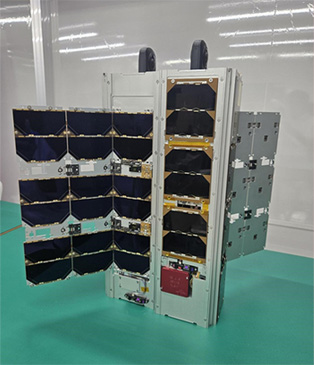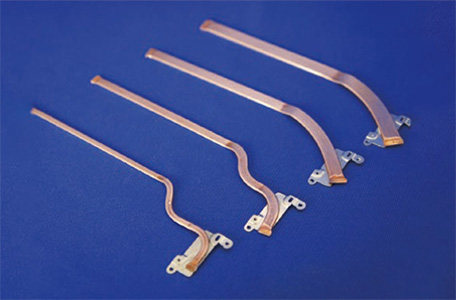Demonstration satellite “FUNADE” scheduled to launch in 2026
- Promoting co-creation through demonstrations in space -
- The jointly developed satellite FUNADE is scheduled to launch in October 2026 and will conduct in-orbit demonstrations over a one-year period
- Furukawa Electric will verify the reliability and stability of the company’s satellite components, as well as work to develop new products directed at advancing the space business
- The University of Tokyo aims to acquire basic data that will lead to the realization of high precision formation flight satellites in the future
Furukawa Electric Co., Ltd. (Head office: 2-6-4 Otemachi, Chiyoda-ku, Tokyo; President: Hideya Moridaira; hereinafter “Furukawa Electric”) and Graduate School of Engineering, The University of Tokyo (7-3-1 Hongo, Bunkyo-ku, Tokyo; Dean: Yasuhiro Kato; hereinafter “University of Tokyo”) will launch the demonstration satellite FUNADE in October 2026. The satellite was designed and developed through the social collaboration course “Formation of a business ecosystem for small and micro satellites” (Course leader: Professor Shinichi Nakasuka) established in the university in 2023, and it will be used to conduct an in-orbit demonstration of Furukawa Electric’s satellite components and verify the basic operations of formation flight being researched by University of Tokyo.
Background
In recent years, the global space industry market has grown to about JPY 54 trillion, and it is forecast to grow further in the future following use by various domains and applications (Note 1). In the satellite market, the use of small and micro satellites, which can be developed quicker and at lower cost than large satellites, is expected to increase. In particular, there is growing possibility of a huge spike in satellite development as a result of small satellite constellations (Note 2) that use many satellites for missions such as earth observations and establishing telecommunications infrastructure. Rapid design responses and stable manufacturing technology will be the source of important competitive advantages in the space industry. Furukawa Electric and University of Tokyo established the social collaboration course at the university in April 2023 and have studied multiple issues directed at acquiring technology mainly in the design and development of components equipped in small and micro satellites required in high numbers in the future and the establishment of more efficient and high value-added satellite manufacturing and supply systems (Note 3).
Details
Furukawa Electric and University of Tokyo will launch the jointly developed demonstration satellite FUNADE in October 2026 and conduct in-orbit demonstrations over the following year until October 2027.
Overview of the demonstration satellite FUNADE
FUNADE consists of two 4U size (110mm×123mm×499mm) CubeSat satellites and can operate in a docked and separated state through a deployment mechanism. The two 4U satellites have a nearly identical structure, and using the results of this demonstration to establish a mass production system will contribute to the realization of a stable, efficient satellite manufacturing system at Furukawa Electric.

In-orbit demonstration of Furukawa Electric’s satellite components
Along with verifying the reliability and stability of products including the heat pipe module that was improved specifically for FUNADE, we will continue to design and develop components for satellites. Also, we will verify efficient, high value-added satellite manufacturing and supply systems based on the results of the demonstration. In addition, we will work to develop new products aimed at the advancement of the space business.
| Item | Specifications |
|---|---|
| Mission | Verify the activation of our components, verify basic formation flight operations and take 360° camera photographs |
| Developed components | Heat pipe module, S-band transceiver (S-TRx) and S-band antenna, on-board computer (OBC) and high durability aluminum alloy wire EFDURAL® |
| Size | 4U CubeSat (110mm×123mm×499mm)×2 |
| Weight | 16kg max |
| Orbit | Sun synchronous orbit |
| Altitude | 500km |
| Launch rocket | US-made rocket |

A heat pipe module that operates below freezing point and has excellent thermal conductivity under reverse operation (top heat). Ideal for thermal management in space where air convection heat dissipation is not possible.

An S-band transceiver with size and weight suitable for micro satellites, supporting multiple modulation/demodulation methods and high bit rates for high-speed communications. Enables rapid commands from the ground and achievement of more advanced missions.

An OBC with high signal and computation processing capabilities, designed for rewriting in orbit. Supports rapid development of satellites with diverse configurations and missions.

New aluminum alloy wire with fine crystal grains developed using our unique metal technology. Strength is more than double that of pure aluminum, with vibration resistance and repeated bending resistance increased to over 100 times, while maintaining formability for bending and twisting processes.
Basic operations of formation flight (Note 4) satellites pursued by University of Tokyo
Utilizing the features of this demonstration satellite made up of two individual units, by equipping each satellite with a GPS receiver, camera and high precision sensors that apply laser technology, efforts will be made to verify these sensors in space and acquire basic data that will lead to the realization of high precision formation flight satellites in the future.

(note 1)“Ministry of Economy, Trade and Industry initiatives and future outlook based on the global trends in the space industry” issued by the Ministry of Economy, Trade and Industry (March 2024)
(note 2)Arrangement of multiple small satellites in orbit that work together to carry out an advanced mission
(note 3)Overview of the social collaboration course
| Course name | Creation of business ecosystems for small satellites and micro satellites |
|---|---|
| Research topic | Formation of a business ecosystem that produces competitive satellite services based on the establishment and enhancement of development, manufacturing and supply systems for small and micro satellites |
| Course leader | Professor Shinichi Nakasuka (Department of Aeronautics and Astronautics, Graduate School of Engineering, University of Tokyo) |
| Research locations | University of Tokyo and Furukawa Electric |
| Course term | April 1, 2023 – March 31, 2026 (preparations underway to extend) |
(note 4)Formation flight: Technology for using multiple satellites that work together to achieve a single mission. By controlling the location and position of each satellite, it will be possible to create large-scale observation systems spanning several hundred meters to several kilometers without being limited by the size of the individual satellites.
EFDURAL is a registered trademark of Furukawa Electric Co., Ltd. in Japan.
Related website
Inquiry
Furukawa Electric Co., Ltd.
Public Relations Department
E-MAIL: fec.pub@furukawaelectric.com
University of Tokyo
School of Engineering Public Relations Office
E-MAIL: kouhou@pr.t.u-tokyo.ac.jp
Furukawa Electric Group's approach to the SDGs
Considering the United Nations' Sustainable Development Goals (SDGs), the Furukawa Electric Group has established the Furukawa Electric Group Vision 2030, with the year 2030 as its target. This initiative aims to "establish a social infrastructure that integrates information, energy, and mobility to safeguard the global environment and facilitate safe, secure, and comfortable living." We are currently working towards this objective. To achieve our Vision 2030, we will contribute to the achievement of the SDGs by promoting Open, Agile, and Innovative ESG management that aims to enhance our corporate value over the medium to long term.







 Share
Share Tweet
Tweet Share
Share